Products and Features
- Getting Started with CloudRaya Container Registry
- How to use Sudo on a CloudRaya Linux VM
- Keeping Your CloudRaya Linux VMs Up-to-Date
- Maximizing StorageRaya with Essential Practices
- Assign Multiple IP Addresses to Virtual Machine
- Generating a CloudRaya API key
- Simplify CloudRaya Management with API
- Deploying a Virtual Machine on CloudRaya
- Deploying a Kubernetes Cluster on KubeRaya
- Using StorageRaya – CloudRaya S3 Object Storage
- Opening Ping Access on Cloud Raya VM Public IP
- Maximize Your Storage Raya Access Speed with Content Delivery Network (CDN)
- How to Create Project Tag in Cloud Raya for More Organized VM Billing Report
- Exporting Cloud Raya VM to outer Cloud Raya's Infrastructure using Acronis Cyber Protect
- SSO Management on Cloud Raya
- Easy Steps to Enable VPC in Cloud Raya
- Using the SSH key Feature in Cloud Raya Dashboard
- Cloud Raya Load Balancer, Solution to Distribute Load Equally
- Create your own VPN server with DNS-Level AdBlocker using PiVPN
- Fix Broken LetsEncrypt SSL Certificate due to Expired Root CA Certificate
- How to Make a Snapshot and Configure VM Backup in Cloud Raya
- How to Request Services or Licenses Products
- Adding, Attaching, and Resize Root Storage Disk in Cloud Raya VPS
- Managing your DNS Zone with DNS Bucket in Cloud Raya
- Create VM, Custom Package, Reinstall VM, and Adjusting Security Profile
- How to backup Linux VM via Acronis in Cloud Raya
- How to Backup Desktop Linux and Windows via Acronis in Cloud Raya
- Backing-Up Cloud Raya Windows VM Using Acronis Cyber Protect
- Load Balancing in Cloud Raya
- Establishing a VPN in Cloud Raya
- Generating an API Token
- Deploying a Virtual Machine in Cloud Raya
- Show Remaining Articles ( 17 ) Collapse Articles
- How to backup Linux VM via Acronis in Cloud Raya
- How to Backup Desktop Linux and Windows via Acronis in Cloud Raya
- Maximizing StorageRaya with Essential Practices
- Using StorageRaya – CloudRaya S3 Object Storage
- Building a Static Website Using Storage Raya S3 Bucket
- Integrating S3 Storage Raya and Strapi for Asset Storage Optimization – Part 4
- Maximize Your Storage Raya Access Speed with Content Delivery Network (CDN)
- Managing Storage Raya from various tools and from various OS
- Binding NextCloud with CloudRaya S3 Object Storage as External Storage Mount
- How to use Sudo on a CloudRaya Linux VM
- Keeping Your CloudRaya Linux VMs Up-to-Date
- Implement Multi-Factor Authentication on CloudRaya Linux VM
- Assign Multiple IP Addresses to Virtual Machine
- Deploying a Virtual Machine on CloudRaya
- Configurating cPanel Using Ubuntu 20.04 on CloudRaya – Part 2
- Deploying cPanel Using Ubuntu 20.04 on CloudRaya - Part 1
- Exporting Cloud Raya VM to outer Cloud Raya's Infrastructure using Acronis Cyber Protect
- Using the SSH key Feature in Cloud Raya Dashboard
- Adding, Attaching, and Resize Root Storage Disk in Cloud Raya VPS
- Create VM, Custom Package, Reinstall VM, and Adjusting Security Profile
- How to backup Linux VM via Acronis in Cloud Raya
- Backing-Up Cloud Raya Windows VM Using Acronis Cyber Protect
- Deploying a Virtual Machine in Cloud Raya
Integration
- Implement Multi-Factor Authentication on CloudRaya Linux VM
- Accessing KubeRaya Cluster Using the Kubernetes Dashboard
- Building a Static Website Using Storage Raya S3 Bucket
- Integrating S3 Storage Raya and Strapi for Asset Storage Optimization – Part 4
- Integrating Strapi Content to Frontend React - Part 3
- Content Management with Strapi Headless CMS - Part 2
- Strapi Headless CMS Installation in CloudRaya - Part. 1
- Using SSH Key on CloudRaya VM with PuTTY
- Installing Multiple PHP Versions in One VM for More Flexible Web Development
- Replatforming Apps to K8s with RKE and GitLab CI
- OpenAI API Integration: Completions in PHP
- Building an Email Server on CloudRaya Using iRedMail
- Improving Email Delivery with Sendinblue SMTP Relay
- Building a Self Hosted Password Manager Using Passbolt
- How to Install Podman on Almalinux/Rocky Linux 9
- ElkarBackup: GUI Based backup Tools based on Rsync and Rsnapshot
- Improving Webserver Performance with SSL Termination on NGINX Load Balancer
- Using NGINX as an HTTP Load Balancer
- Automating Task with Cronjob
- Upgrade Zimbra and the OS Version
- Deploy Mailu on Rancher Kubernetes
- Export and Import Database in MySQL or MariaDB Using Mysqldump
- Backup & Sync Local and Remote Directories Using RSYNC
- Managing Storage Raya from various tools and from various OS
- Binding NextCloud with CloudRaya S3 Object Storage as External Storage Mount
- Simple monitoring and alerting with Monit on Ubuntu 22.04 LTS
- VS Code on your browser! How to install code-server on a VM
- Implementing Redis HA and Auto-Failover on Cloud Raya
- Using XFCE Desktop Environment on Cloud Raya VM
- Installing Python 3.7-3.9 on Ubuntu 22.04 Jammy LTS using PPA
- Implementing Continuous Integration with Gitlab CI and Continuous Delivery with Rancher Fleet
- Using Collabora Online on Cloud Raya NextCloud's VM
- Installing NextCloud in Cloud Raya- Detail Steps from the Beginning to the Very End
- Set Up High Availability PostgreSQL Cluster Using Patroni on Cloud Raya
- Set Up WAF KEMP in Cloud Raya Part 2
- Set Up WAF KEMP in Cloud Raya Part 1
- Using the SSH key Feature in Cloud Raya Dashboard
- Monitor Your Services Uptime Using Uptime Kuma
- Hosting Static Website with Hugo on Cloud Raya
- Kubernetes Ingress Controller using SSL in CloudRaya
- Reverse Proxy management using Nginx Proxy Manager
- Create your own VPN server with DNS-Level AdBlocker using PiVPN
- How to deploy Portainer on Linux to easily manage your docker containers
- High Availability Kubernetes Using RKE in Cloud Raya Part 3
- High Availability Kubernetes Using RKE in Cloud Raya Part 2
- High Availability Kubernetes Using RKE in Cloud Raya Part 1
- How to backup Linux VM via Acronis in Cloud Raya
- How to Backup Desktop Linux and Windows via Acronis in Cloud Raya
- Deploying Magento on Cloud Raya
- How to Install Nextcloud on Cloud Raya
- How to Install CWP in Cloud Raya
- How to Install Node.js and Launch Your First Node App
- How to install and secure MariaDB on Ubuntu 18.04 and 20.04 on Cloud Raya
- How to Install and Securing MongoDB on Ubuntu 18.04 and 20.04
- Classes: Post Installation on Ansible
- Classes: Install and Configure Ansible
- Classes: Introduction to Ansible for a robust Configuration Management
- How to Setup Active Directory Domain Service & DNS with Cloud Raya
- How to Host Your Own Docker Hub in Cloud Raya
- How to Setup Your Own Laravel with Nginx in Ubuntu 18.04
- How to Deploy Container in Cloud Raya using Docker
- Securing CentOS with iptables
- Install and Configure Squid Proxy in Ubuntu
- Installing Apache and Tomcat: A Quick Way
- Securing Ubuntu with UFW
- Install a Node.js and Launch a Node App on Ubuntu 18.04
- Installing LAMP in Ubuntu
- Installing LEMP Stack on Ubuntu 18.04
- Show Remaining Articles ( 53 ) Collapse Articles
- Articles coming soon
- Implement Multi-Factor Authentication on CloudRaya Linux VM
- Configurating cPanel Using Ubuntu 20.04 on CloudRaya – Part 2
- Deploying cPanel Using Ubuntu 20.04 on CloudRaya - Part 1
- Integrating S3 Storage Raya and Strapi for Asset Storage Optimization – Part 4
- Integrating Strapi Content to Frontend React - Part 3
- Content Management with Strapi Headless CMS - Part 2
- Strapi Headless CMS Installation in CloudRaya - Part. 1
- Using SSH Key on CloudRaya VM with PuTTY
- Building an Email Server on CloudRaya Using iRedMail
- Improving Email Delivery with Sendinblue SMTP Relay
- Building a Self Hosted Password Manager Using Passbolt
- ElkarBackup: GUI Based backup Tools based on Rsync and Rsnapshot
- Improving Webserver Performance with SSL Termination on NGINX Load Balancer
- Using NGINX as an HTTP Load Balancer
- Upgrade Zimbra and the OS Version
- Deploy Mailu on Rancher Kubernetes
- Managing Storage Raya from various tools and from various OS
- Binding NextCloud with CloudRaya S3 Object Storage as External Storage Mount
- Simple monitoring and alerting with Monit on Ubuntu 22.04 LTS
- VS Code on your browser! How to install code-server on a VM
- Implementing Redis HA and Auto-Failover on Cloud Raya
- Using XFCE Desktop Environment on Cloud Raya VM
- Implementing Continuous Integration with Gitlab CI and Continuous Delivery with Rancher Fleet
- Using Collabora Online on Cloud Raya NextCloud's VM
- Installing NextCloud in Cloud Raya- Detail Steps from the Beginning to the Very End
- Set Up WAF KEMP in Cloud Raya Part 2
- Set Up WAF KEMP in Cloud Raya Part 1
- Monitor Your Services Uptime Using Uptime Kuma
- Create your own VPN server with DNS-Level AdBlocker using PiVPN
- How to deploy Portainer on Linux to easily manage your docker containers
- High Availability Kubernetes Using RKE in Cloud Raya Part 3
- High Availability Kubernetes Using RKE in Cloud Raya Part 2
- High Availability Kubernetes Using RKE in Cloud Raya Part 1
- How to Install Nextcloud on Cloud Raya
- Classes: Post Installation on Ansible
- Classes: Install and Configure Ansible
- Classes: Introduction to Ansible for a robust Configuration Management
- Connect Windows Active Directory on Cloud Raya with Azure AD
- How to Host Your Own Docker Hub in Cloud Raya
- How to Deploy Container in Cloud Raya using Docker
- Show Remaining Articles ( 25 ) Collapse Articles
- Accessing KubeRaya Cluster Using the Kubernetes Dashboard
- Integrating S3 Storage Raya and Strapi for Asset Storage Optimization – Part 4
- Integrating Strapi Content to Frontend React - Part 3
- Content Management with Strapi Headless CMS - Part 2
- Strapi Headless CMS Installation in CloudRaya - Part. 1
- Creating Interactive Chatbot with OpenAI API in PHP
- Installing Multiple PHP Versions in One VM for More Flexible Web Development
- OpenAI API Integration: Completions in PHP
- Improving Webserver Performance with SSL Termination on NGINX Load Balancer
- Using NGINX as an HTTP Load Balancer
- Automating Task with Cronjob
- How to Deploy Django App on Cloud Raya VM Using Gunicorn, Supervisor, and Nginx
- How to Install Node.js and Launch Your First Node App
- How to Setup Your Own Laravel with Nginx in Ubuntu 18.04
- Install a Node.js and Launch a Node App on Ubuntu 18.04
- How to use Sudo on a CloudRaya Linux VM
- Keeping Your CloudRaya Linux VMs Up-to-Date
- Implement Multi-Factor Authentication on CloudRaya Linux VM
- Using SSH Key on CloudRaya VM with PuTTY
- Building a Self Hosted Password Manager Using Passbolt
- Improving Webserver Performance with SSL Termination on NGINX Load Balancer
- Export and Import Database in MySQL or MariaDB Using Mysqldump
- Backup & Sync Local and Remote Directories Using RSYNC
- How to Deploy Django App on Cloud Raya VM Using Gunicorn, Supervisor, and Nginx
- Set Up WAF KEMP in Cloud Raya Part 2
- Set Up WAF KEMP in Cloud Raya Part 1
- Using the SSH key Feature in Cloud Raya Dashboard
- How to backup Linux VM via Acronis in Cloud Raya
- How to Backup Desktop Linux and Windows via Acronis in Cloud Raya
- Securing CentOS with iptables
- Securing Ubuntu with UFW
- Show Remaining Articles ( 1 ) Collapse Articles
- Configurating cPanel Using Ubuntu 20.04 on CloudRaya – Part 2
- Deploying cPanel Using Ubuntu 20.04 on CloudRaya - Part 1
- Integrating S3 Storage Raya and Strapi for Asset Storage Optimization – Part 4
- Integrating Strapi Content to Frontend React - Part 3
- Content Management with Strapi Headless CMS - Part 2
- Strapi Headless CMS Installation in CloudRaya - Part. 1
- Creating Interactive Chatbot with OpenAI API in PHP
- Installing Multiple PHP Versions in One VM for More Flexible Web Development
- Building an Email Server on CloudRaya Using iRedMail
- Building a Self Hosted Password Manager Using Passbolt
- Improving Webserver Performance with SSL Termination on NGINX Load Balancer
- Using NGINX as an HTTP Load Balancer
- Installing Python 3.7-3.9 on Ubuntu 22.04 Jammy LTS using PPA
- Reverse Proxy management using Nginx Proxy Manager
- Install and Configure Squid Proxy in Ubuntu
- Installing Apache and Tomcat: A Quick Way
- Installing LAMP in Ubuntu
- Installing LEMP Stack on Ubuntu 18.04
- Show Remaining Articles ( 3 ) Collapse Articles
- Building a Static Website Using Storage Raya S3 Bucket
- Integrating S3 Storage Raya and Strapi for Asset Storage Optimization – Part 4
- Integrating Strapi Content to Frontend React - Part 3
- Content Management with Strapi Headless CMS - Part 2
- Strapi Headless CMS Installation in CloudRaya - Part. 1
- Creating Interactive Chatbot with OpenAI API in PHP
- Installing Multiple PHP Versions in One VM for More Flexible Web Development
- OpenAI API Integration: Completions in PHP
- Hosting Static Website with Hugo on Cloud Raya
- Deploying Magento on Cloud Raya
- How to Install CWP in Cloud Raya
- How to Setup Active Directory Domain Service & DNS with Cloud Raya
- Articles coming soon
Easy Steps to Enable VPC in Cloud Raya
Do you know that Virtual Private Cloud (VPC) is now ready on Cloud Raya panel? But, before that you need to make sure yourself is familiar with what VPC is.
VPC is a networking feature which replace the Default Network with Security Profile feature that previously existed in Cloud Raya.

For Cloud Raya accounts from existing customers, this VPC feature will not automatically appear in the Networking menu, but still displays the Security Profile menu.
However, for customers who have just created a Cloud Raya account after the official VPC release, it will automatically be active and the Security Profile will disappear.

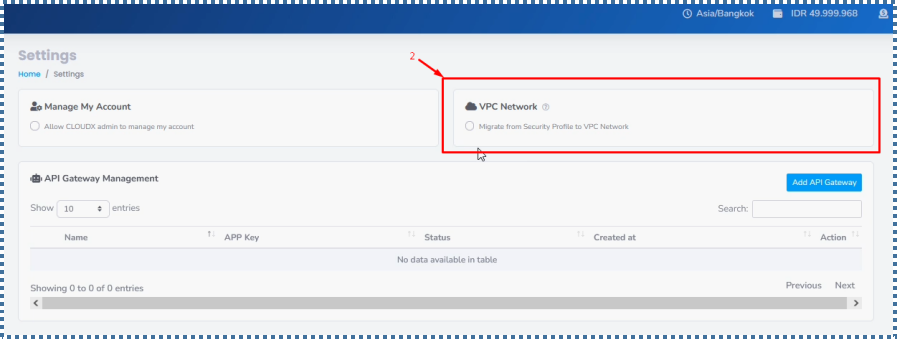

If you are still comfortable with the Default Network with Security Profile, where you only need to enter the port, the IP, without any advanced configuration, then you can still use the Security Profile.
But if you want a feature with the benefit that we can isolate some of our resources (VMs) with certain IPs, more advanced ACL control, and we don’t need to re-apply every time we make changes to the ACL Rules, then VPC is the answer.
Although in order to continue using Cloud Raya and add new VM resources, we are required to switch to VPC.
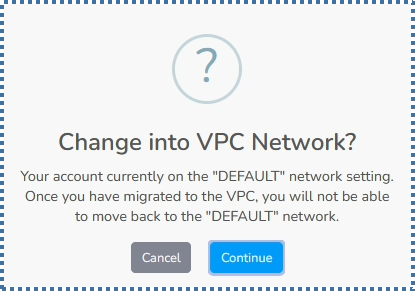

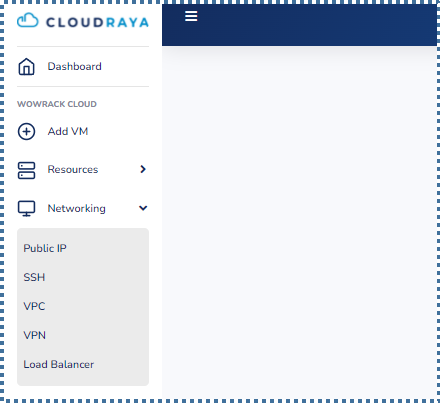
Then the question now is how to configure the VPC in Cloud Raya, is it much more confusing and difficult than the Security Profile?
Of course not! Although the features offered are much more advanced, Cloud Raya with its User Friendly Panel slogan, will still make it easy for you to manage VPCs.
Let’s see how!
Configuring the VPC in Cloud Raya

On the Virtual Private Cloud tab, a list of the VPC networks that we already have in a particular region/location will appear.
To start creating a VPC network, we can click on the “Create VPC” button.
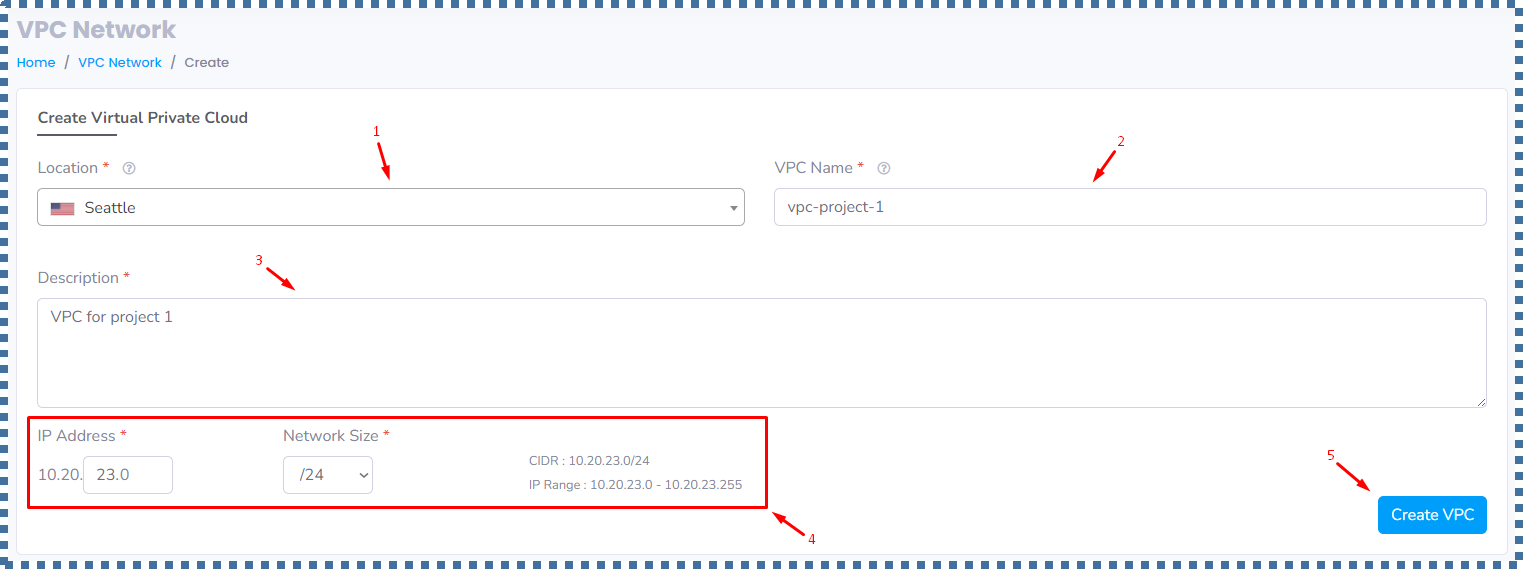
| 1. | Location | : | We select the region where we want to create this VPC Network. You can fill according to the location of the VM you want to launch. In this tutorial I will choose Seattle. |
| 2. | VPC Name | : | We fill in the name of the VPC network that we want to create. |
| 3. | Description | : | We fill in the description of the VPC network. |
| 4. | IP Address & Network Size | : | In the IP Address, we can specify the IP of the Super Network that we want.In this case I will make the Super Network IP is 10.20.23.0, with Network Size is /24.How many IP ranges can we have on this /24 network size? Don’t worry, the information will automatically appear. Later, in this Super Network, we can create smaller subnets for the needs of each group of resources that we want to isolate from other groups of resources. |
If so, we can click on “Create VPC”.
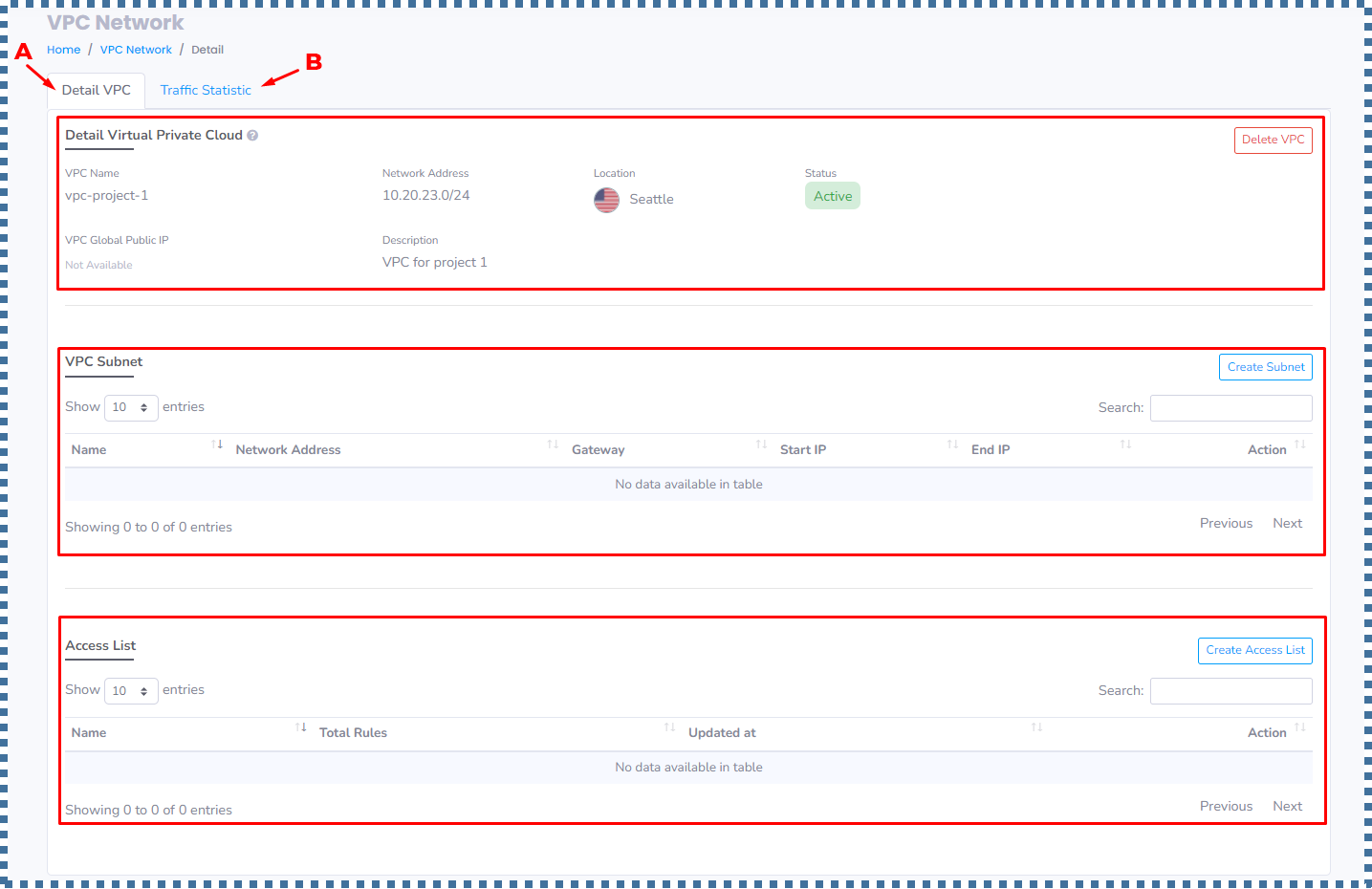
A. Detail VPC
In this tab there are 3 sections, namely:
- Detail Virtual Private Cloud
- VPC Subnet
- Access List
1. Detail Virtual Private Cloud

2. VPC Subnet
This section consist of a list of the subnets that we have will be displayed. To create a new one, we can click on “Create Subnet”.
▶️ Create Subnet
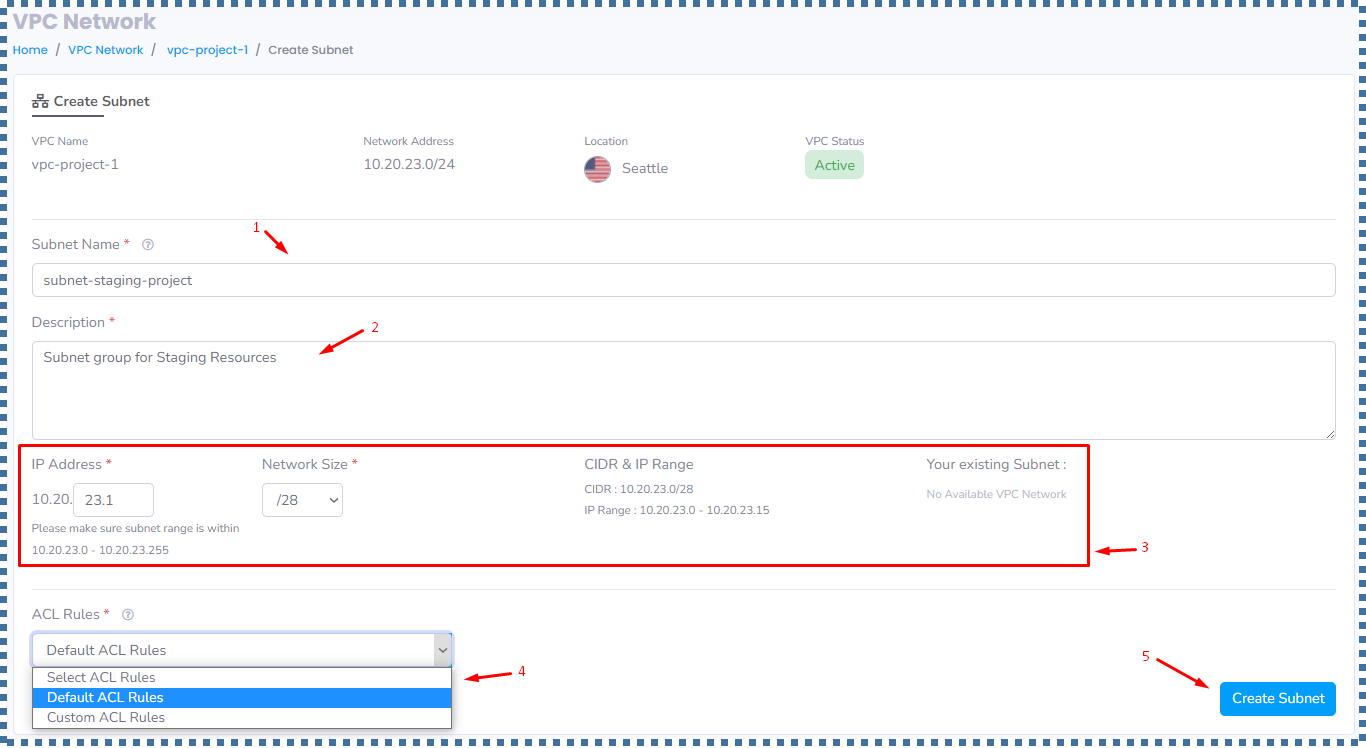
| 1. | Subnet Name | : | We fill in the name of the Subnet that we want to create. |
| 2. | Description | : | We fill in the description of the subnet. |
| 3. | IP Address & Network Size | : | In this field, we can specify the range of Subnets we want for the resources we create.The range of the subnet must still be within the range of the Super Network that we created earlier (/24).In this tutorial I will create a subnet IP of 10.20.23.1, with a network size of /28 |
| 4. | ACL Rules | : | Is a collection of firewall rules that we can customize.Conceptually, ACL Rules are the same as Security Profile, where we can specify which ports we want to open.In this step we select the Default ACL Rules first, for later we will adjust it again in the next step. |
If so, click “Create Subnet”.
▶️ Managing Subnet Lists
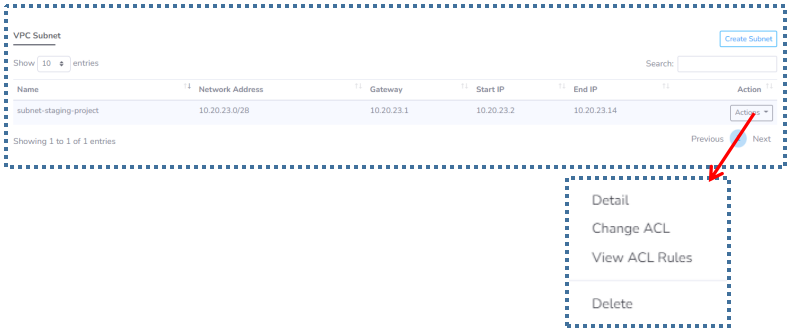
Detail
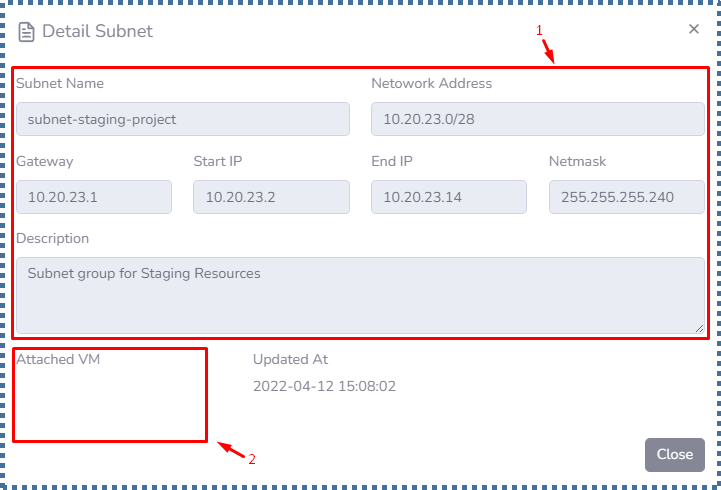
Change ACL
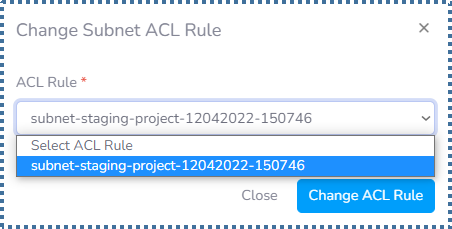
View ACL Rules
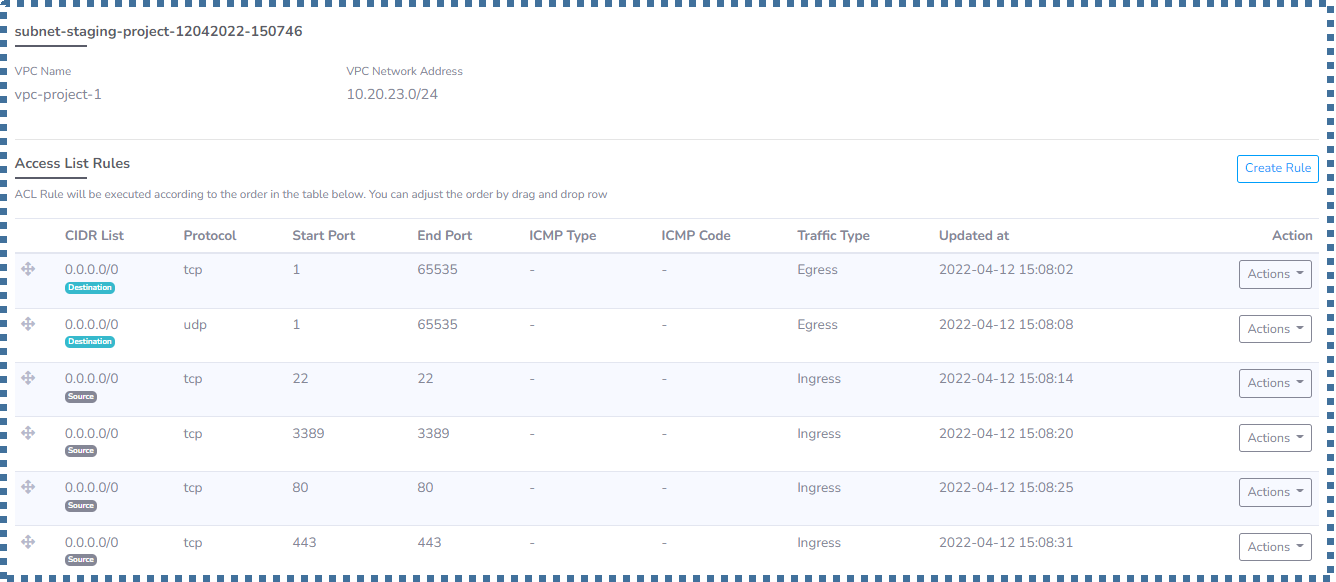
Delete
In this option, we can delete the Subnet that we have. But please make sure that there are no VMs attached to this Subnet. Because if not, an error message will appear as follows.

2. Access List
In line with the previous ACL Rules explanation on the Create Subnet page, when we finish creating the subnet, the ACL Profile will be displayed in this section.

- The total rules in the ACL will also be displayed.
- If we want to add a new Access List, we can click on “Create Access List”.
- In the ACL profile that we already have, we can manage several things such as changing its name, viewing the collection of rules, to deleting this profile.
▶️ Managing ACL Profile
According to point number 3 above, we can do several things on each of our ACL Profiles.
Rename
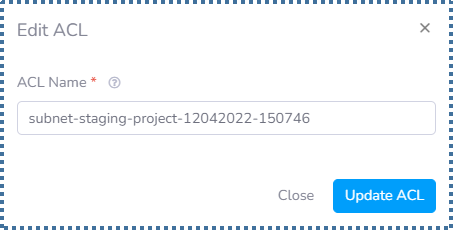
View Rules
Now let’s talk about the rules that are in this default ACL.
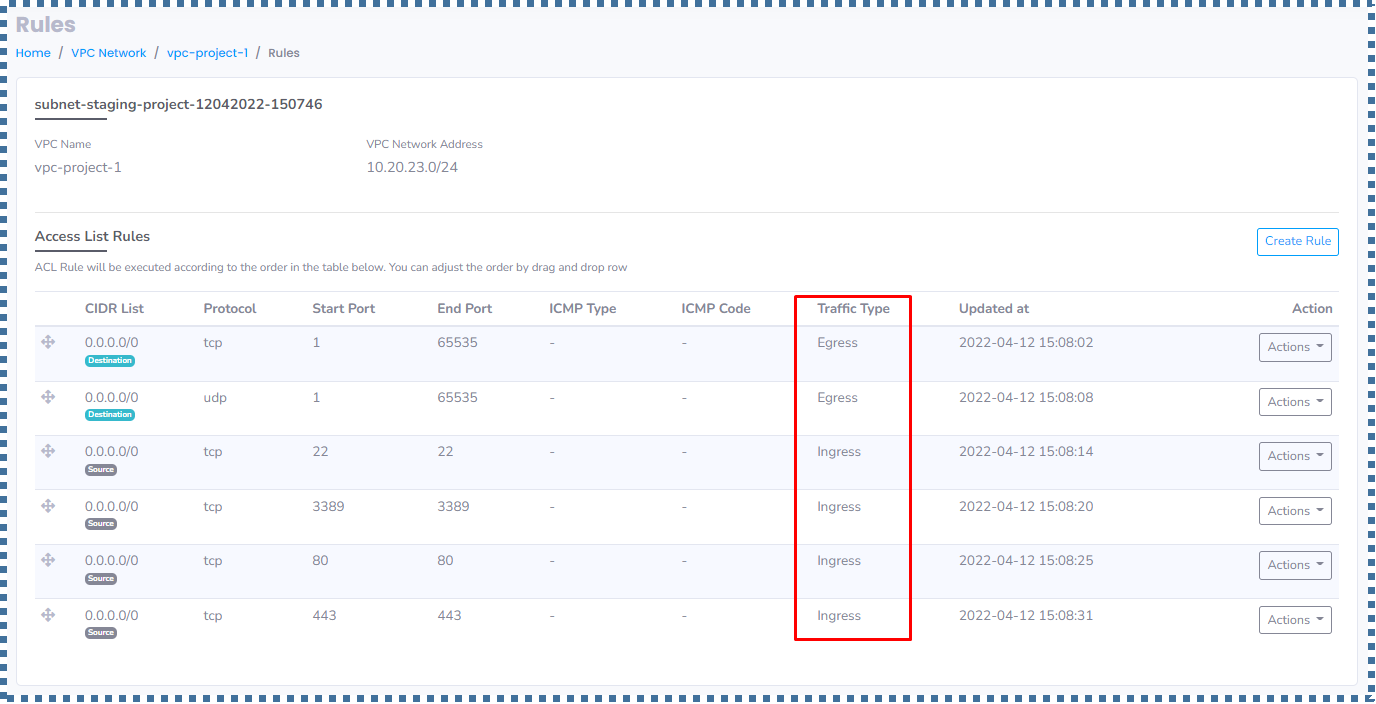
- Egress : The type of traffic whose destination is outbound from our VM.
- Ingress : The type of traffic whose destination is incoming / inbound into our VM.
With each Action in the default ACL listed on the list is “Allow”.
If we try to translate the set of rules above, it will be as follows:
Allow all ports with TCP and UDP protocols from 1 – 65535 from our VM, to be able to go to the internet. And allow ports 22, 3389, 80, 443 with the TCP protocol to be able to enter our VM.
We can also add new rules that we want by clicking on the “Create Rule” button.
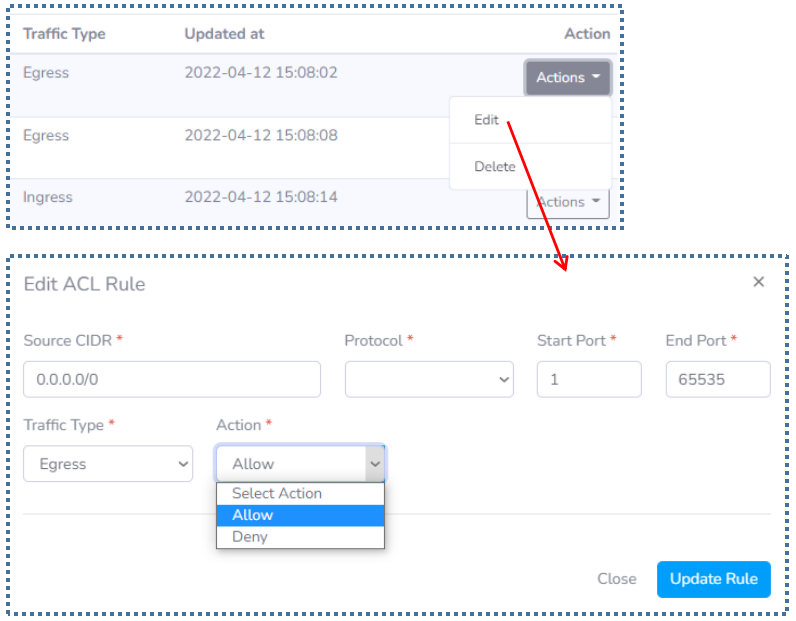
Delete
We can also remove the ACL Profile by clicking on the Delete option. However, please make sure that there are no subnets tied to this ACL Profile. Because if not, an error message like this will appear.
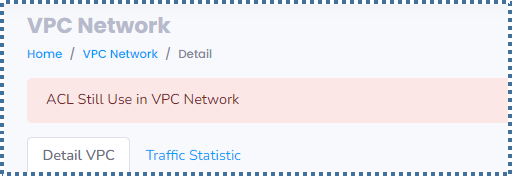
▶️ Create Access List
If we have specific preferences regarding which Port and Protocol details we want to open and deny, or we want to we can do that by clicking on “Create Access List”.


▶️ Import Access Control List rule from the previous Security Profile
When we have created a lot of rules on the Security Profile, of course we don’t want to create those rules again in the Access List in the VPC system.
Relax, you can do this easily in VPC.
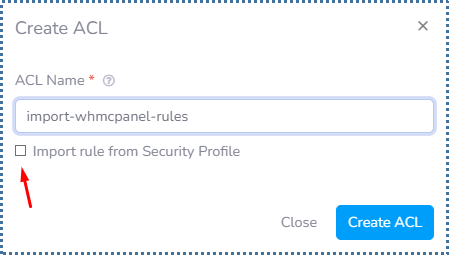
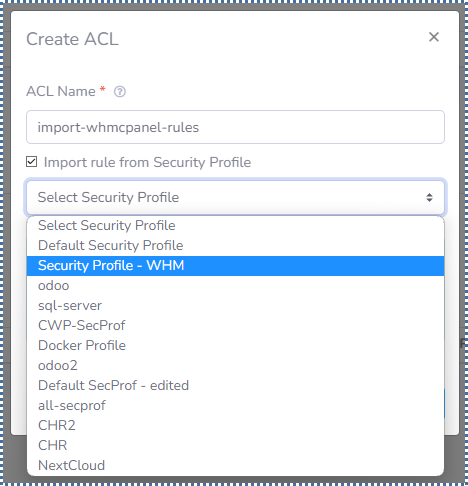
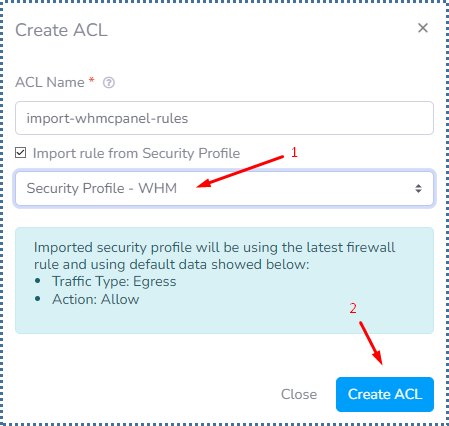

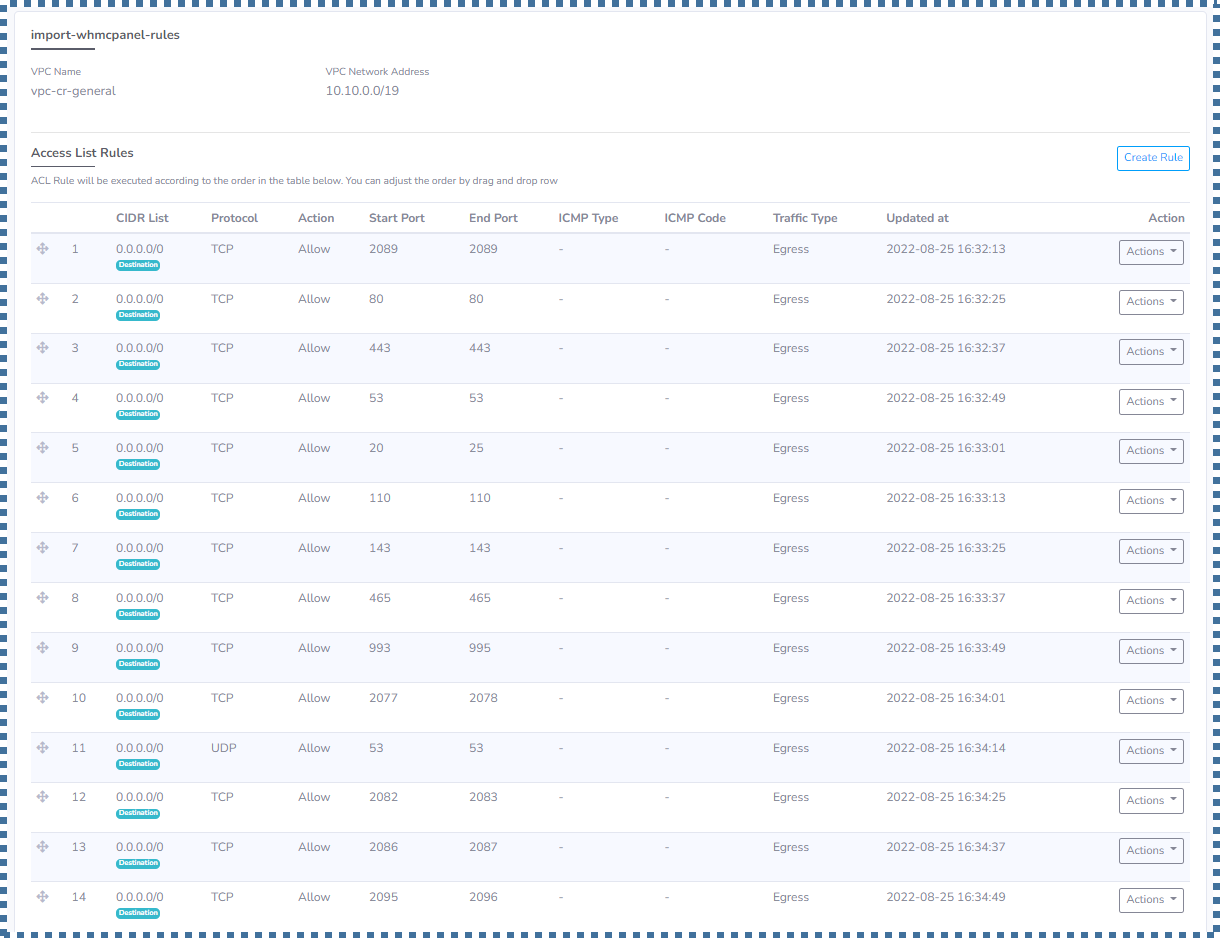
B. Traffic Statistic
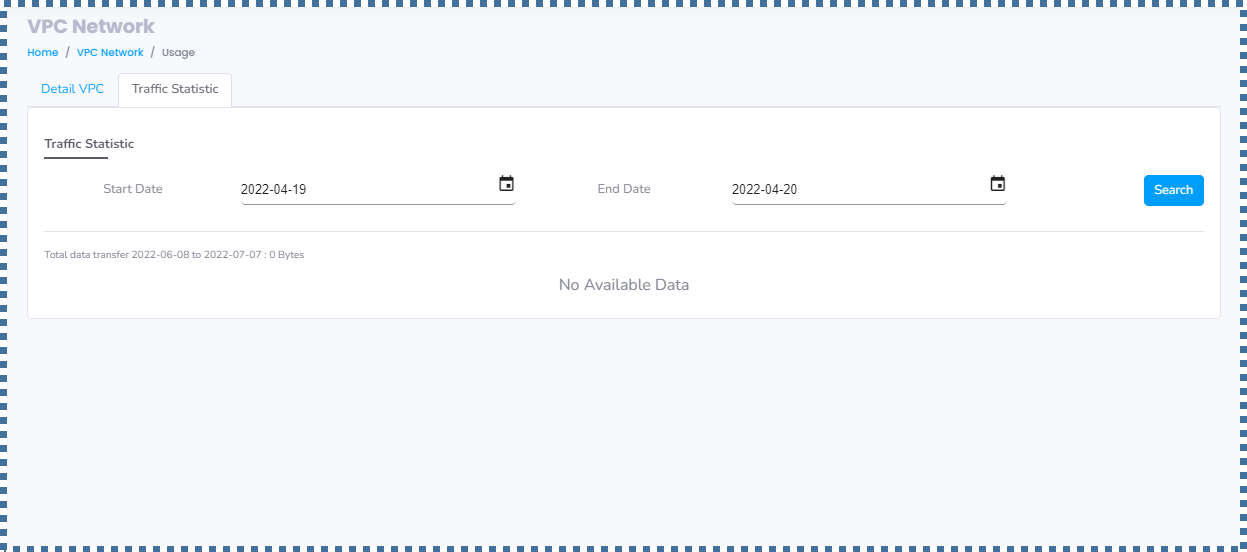
VPC Implementation
After activating and configuring the VPC, now we implement the VPC into the VM that we created.

Where, in this step we can determine the VPC network configuration that we want for the VM.
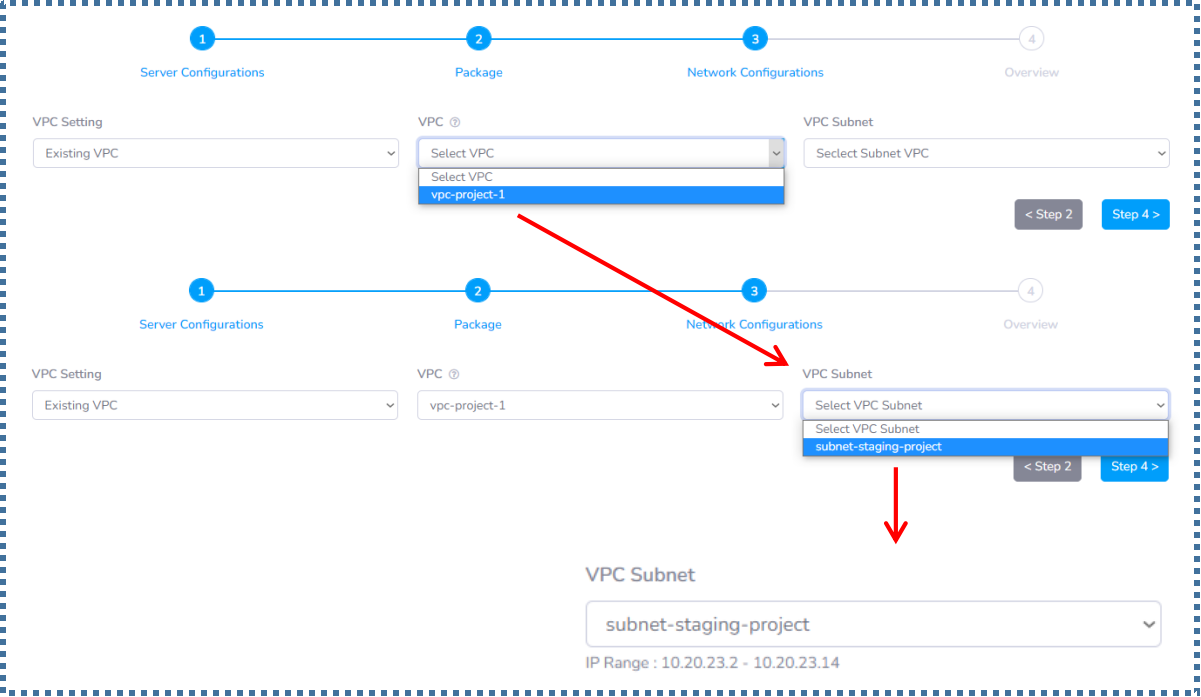
Later, the IP ranges available for our VM will also be displayed. Keep in mind, the VPC profile that appears will adjust from the region where you want to launch the VM.
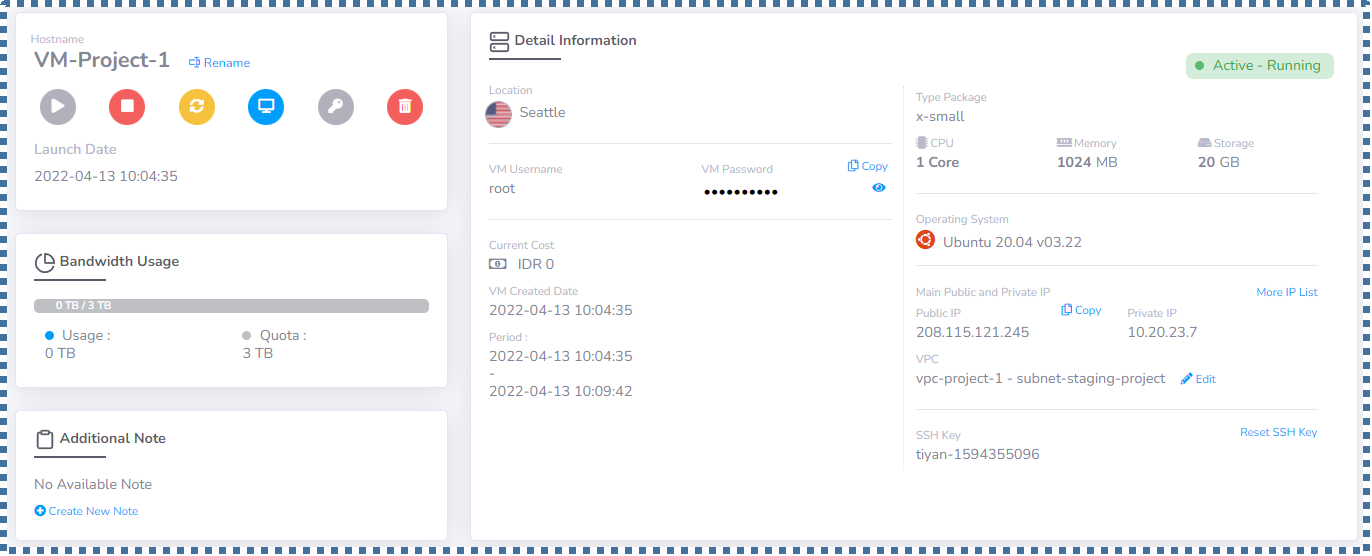
Case Study
In this case study I will create 2 groups of resources.
Where in the Staging resource there are 2 VMs with the subnet range ‘A’, and in the Production resource there are 2 VMs with the subnet range ‘B’.
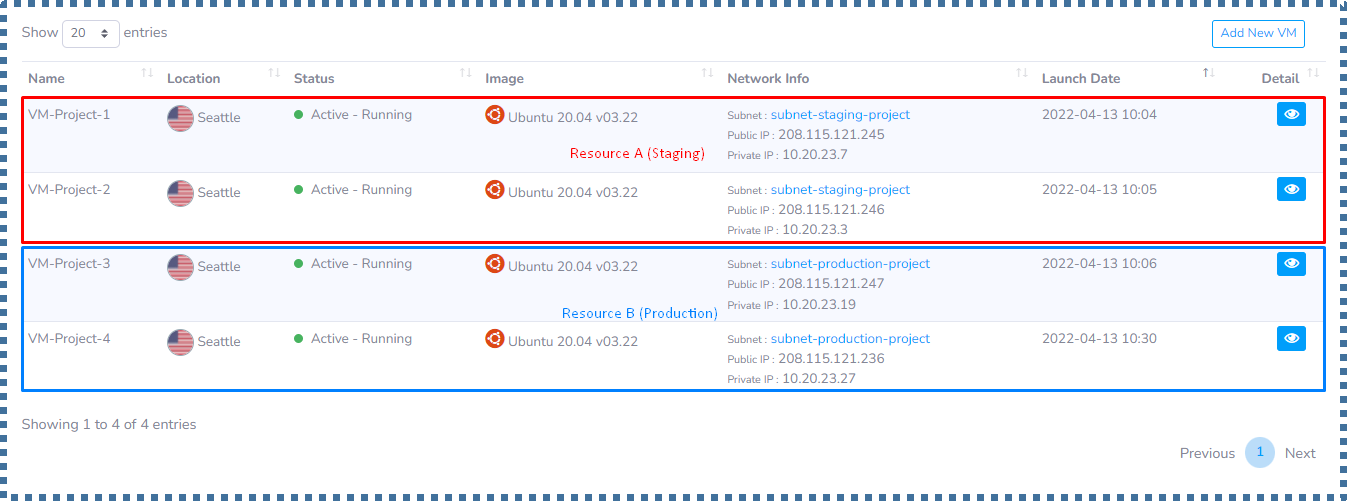
Goals that we will make, are:
- The VM from Staging resource can ping the VM from Production resource,
- Whereas VM from Production resource cannot ping the VM from Staging resource.
To achieve this we will create ACL rules for these 2 types of resources.
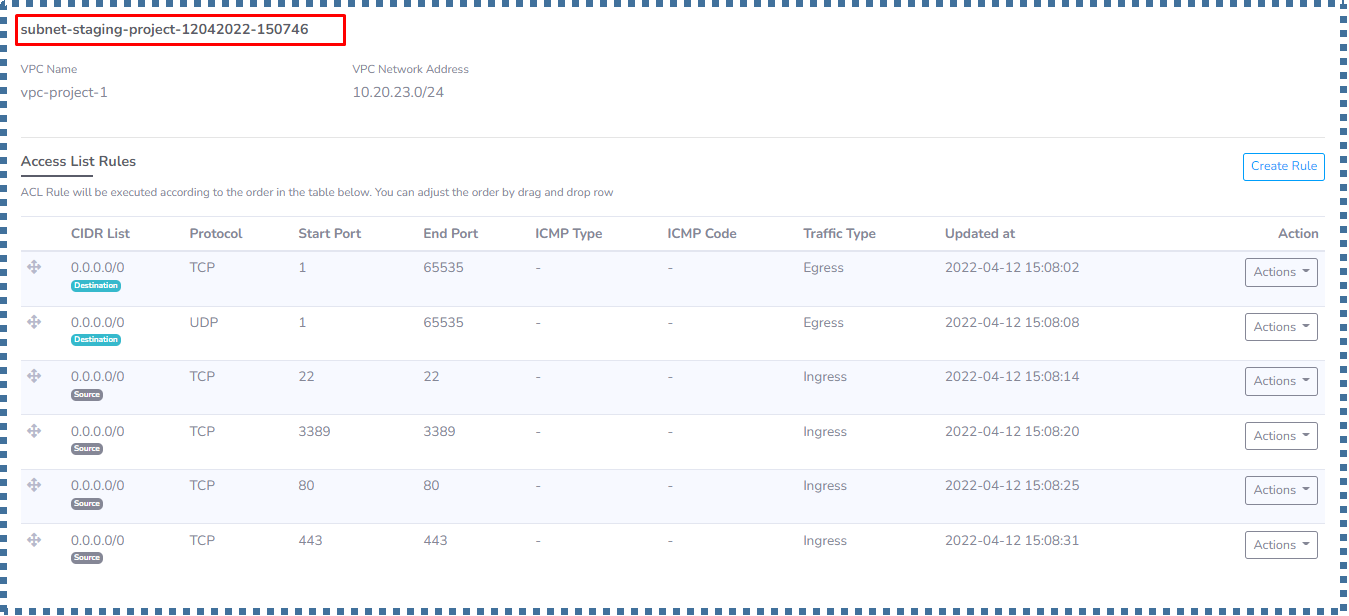
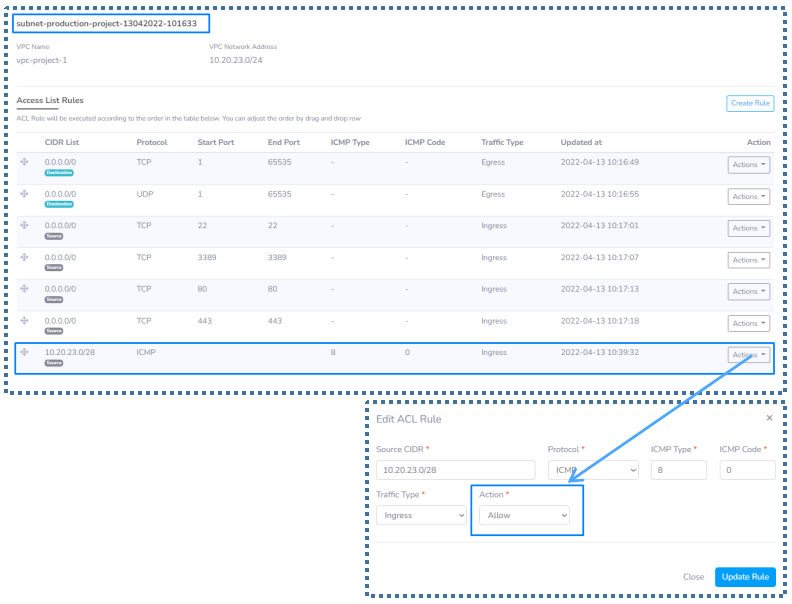

Some things you have to take note about VPC
- Ping can only from the Workstation/PC to the server (but not the other way round).
- In order for ping to works within the VPN network of the VPC, ICMP type 8 code 0 needs to be allowed for Ingress traffic (inbound) and need to at the top of the list,
- Make sure on your VPN configuration, “Allow these Protocols” -> “Microsoft CHAP Version 2” is checked.
▶️ Control Panel -> Network and Internet -> Network Connections -> Properties on your VPN device
▶️ Go to “Security” tab -> checkmark on “Allow these Protocols” -> “Microsoft CHAP Version 2”
- And make sure to uncheck the “Use default gateway on remote network”
▶️ Control Panel -> Network and Internet -> Network Connections -> Properties on your VPN device
▶️ Go to Networking Tab -> double click on Internet Protocol Version 4
▶️ Click Advanced -> IP Settings , uncheck “Use default gateway on remote network”
▶️ Its function is so that the Internet is still running and can also access the VPN/VPC network.
- All VMs within the same VPC Supernetwork can talk to one another. Just need to make sure to allow ICMP pings.
- VMs that belong to different VPC Supernetwork, they need to use the public IP to communicate one another.
Conclusion
Okay that’s a wrap.
In this article, we both know what a VPC is, its benefits and features, how to activate it, its configuration, and implementation in a case study.
If you want to see the video tutorial version, you can access it at the following YouTube link.
For further questions about VPC, please leave your questions in the comment below, or by Cloud Raya’s live chat.
Find more insights and knowledge with tech topic in Cloud Raya’s blog and Knowledge Base. Even better, you can try to start creating new VM and add Cloud Raya’s VPC on it.